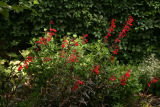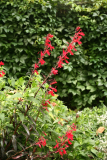Additional notes (click to expand)
Commemorative
The genus was named after Matthias de L’Obel or Lobel (1538–1616), Flemish botanist and physician to James I of England. The family name of L’Obel derives from the French word for the white poplar, ‘aubel’. He was born in Rijsel near Lille in northern France, studied medicine at Leuven (Louvain), where Dodoens studied 20 years previously, and both medicine and botany at Montpelier University (1565– c. 1568), where he was taught by perhaps the most famous teacher of the age, Guillaume Rondelet, regius professor of medicine. Rondelet was so impressed with L’Obel that he gave him all his books. Here L’Obel met Pierre Pena. They came to England in
1569 in the reign of Queen Elizabeth I (1533–1603), and travelled together collecting native plants. When Pena returned to the Continent in 1571 to practise medicine, L’Obel, who had married an Englishwoman, stayed in England for a few months longer. When he returned to the Low Countries (the Netherlands) he practised medicine in Antwerp and then Delft from 1571 to 1581, returning to Antwerp where he became physician to William the Silent, Prince of Orange. After the latter’s assassination in 1584, he returned to England and became superintendent of the garden of Lord Zouche in Hackney. He helped John Gerard publish his herbal (in 1597), an English translation of Dodoens’ herbal, correcting Gerard’s many mistakes and identifying the woodcuts – the majority
of which had been used in the earlier herbals of Fuchs, Mattioli, Dodoens and his own books. In 1606, he became physician and botanist to James I (King of England, 1603–25) and thereafter remained in England, living with his married daughter in Highgate untilhis death.He was buried at the church of St Denis, Highgate, near London.
Oakeley, Dr. Henry. (2012). Doctors in the Medicinal Garden. Plants named after physicians. Royal College of Physicians.
link
He is best known as the author, with Pierre Pena, of the herbal Nova stirpium adversaria (1570/1) published by Thomas Purfoot of London while they were still in England. This was followed by his beautifully illustrated Plantarum seu Stirpium Historia (1576) published by Christopher Plantin of Antwerp, when L’Obel was back in the Netherlands. They can be regarded as a two-volume work as the index to the second edition of the adversaria covers both books. In these they produced one of the earliest classifi cations of plants, grouping them primarily by leaf structure, which resulted in them separating monocotyledons from dicotyledons, although he did not use these terms. For people seeking identifi cation of a plant, all the plants with similar leaf structure – for example, Ranunculus, Aconitum, Helleborus, Geranium, Ricinus, Levisticum with heavily dissected leaves – were grouped together so could be readily compared. This was in marked contrast to Leonhart Fuchs (in 1542) and William Turner (in 1551–68) whose herbals arrange the plants more or less in
alphabetical order of their Latin names. In all they described 1,500 species, with heir medicinal uses in the Stirpium adversaria, but in the Plantarum L’Obel increased the number of woodcuts from 268 to over 2,000 – mostly obtained from the printers of the works of L’Escluse, Dodoens and Mattioli. Linnaeus (1753) has always been credited with introducing the binomial system of genus + species for naming plants, but L’Obel and the other herbalists were already doing this. L’Obel’s Latin index often gave the genus name and author, with frequent binomials, sometimes also with the author, eg Moly Hippocratis; Moly Plin[y]; Mentha tertia Dod[onaeus]. In 1581, L’Obel published his Kruydtboeck in Flemish with 2,181 woodcuts and 1,306 pages, and Plantarum seu stirpium icones (pictures only), but referenced to where the descriptions could be found in his earlier works. The Icones was heavily quoted by Linnaeus in 1753.
Oakeley, Dr. Henry. (2012). Doctors in the Medicinal Garden. Plants named after physicians. Royal College of Physicians. page 103-105
link
Other use
Lobelia cardinalis L Campanulaceae Cardinal lobelia Distribution: Americas, Colombia to south-eastern Canada. The genus was named after Matthias de L’Obel or Lobel, (1538–1616), Flemish botanist and physician to James I of England, author of the great herbal Plantarum seu Stirpium Historia (1576). Lobeline, a chemical from the plant has nicotine like actions and for a while lobeline was used to help people withdraw from smoking, but was found to be ineffective. It was introduced from Virginia to John Parkinson in England by John Newton (1580-1647) a surgeon of Colyton (aka Colliton), Devon, who travelled to Virginia.
Oakeley, Dr. Henry F. (2013). Wellcome Library notes.
link
Geographical distribution
- Northern America
- Southern America
Lobelia cardinalis L.
Family: CAMPANULACEAEGenus: Lobelia
Species: cardinalis L.
Common names: Cardinal Flower; Hog's Sage; Bog's Physic
Distribution summary: N., C. & W.S.America
Habit: Perennial
Garden status: Not currently grown
Reason for growing: Medicinal, toxic

.jpg)
.jpg)
.jpg)
.jpg)

.JPG)
.JPG)